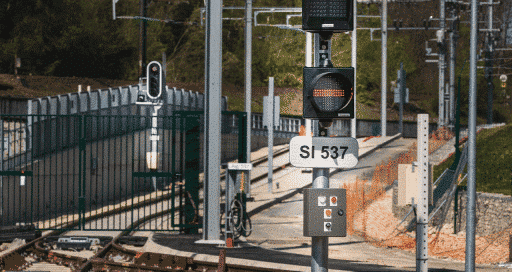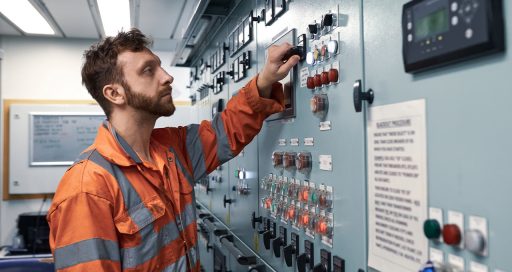Signalling at the centre of accelerating the modal shift to rail
Reading time: 5 min
Energy transition in the highly greenhouse-gas-emitting transport sector involves the development of rail. To accelerate the process, the sector needs low-cost, resilient, flexible equipment. And Mobility’s strategic approach to signalling encapsulates this perfectly.

The business unit Mobility specialises in signalling systems that combine performance, safety and frugality.
The transport sector represents more than one-quarter of all greenhouse gas emissions in the European Union, according to the European Environment Agency.
But the relative emissions from different modes of transport in the sector vary widely. In France, for example, according to ADEME, “Per person and per kilometre, trains pollute eight times less than cars”. Developing rail travel, whether transporting passengers or goods, is therefore key to accelerating ecological progress and the subject of various EU priority schemes.
Rail’s low carbon footprint in France is primarily due to the energy efficiency inherent in this mode of transport. But to see the light of day and get used, rail infrastructure must be economically accessible and thus requires high-performance, lower-cost fixed assets. Signalling is a key part of this infrastructure.
“Accelerating the modal shift to rail for passengers and goods involves the development of signalling systems that are less costly, longer lasting, cleaner and better performing”, says Stéphane Berthet, Signalling Business Unit Manager at Mobility.
This VINCI Energies business unit specialises in the design and implementation of signalling systems that combine performance, safety and frugality. This is a somewhat iconoclastic approach in a railway signalling market dominated by the three electronics giants Thalès, Alstom and Hitachi, whose proprietary solutions proliferate across the network.
Faced with this de facto near-monopoly, the only choice for challengers looking for a place is to focus on innovation.
Open mass production
Mobility has built its offer on three principles: openness, modularity and optimal sizing of signalling systems. First, the business unit is positioned as an integrator, designing its architecture and software in a completely open way.
“We retain no intellectual property, and 100% of the materials used are commercially available, and in quantity”, says Stéphane Berthet. “When we sell a project, we supply every component: source code, validation systems, components. Our customers are then free to adapt their systems according to their needs”.
Second, the equipment used is manufactured in huge quantities – many tens of thousands of the automated safety systems are made every year, for instance – whereas production runs for proprietary solutions are limited to a few hundred items a year. All components are individually modifiable and interchangeable with other products on the market, ensuring a long life for the system in the event there is a problem with any single component.
“Our modular model allows us to configure our solutions precisely to our customers’ needs.”
And third, Mobility is not trying to sell oversized systems. As the business unit manager explains, “Our modular model allows us to configure our solutions precisely to our customers’ needs”.
A leader in tram signalling
In 2015, this open approach enabled Mobility to win over its first customers in the form of tram network operators. City transport authorities in Luxembourg, Nice, Caen, Bordeaux and Brussels, along with Ile de France Mobilités, adopted its automated systems.
“We are the market leader in tram signalling in France”, says Stéphane Berthet. “But the biggest potential is in rail. Currently, we are entering the market via small regional lines, sidings, technicentres and shunting yards”. Other targets include: organising authorities, technicentre operators, ports and industrial sites, infrastructure managers, and private or tourist networks.
In 2019, Mobility secured the contract for the SNCF Tram-Train T12 and T13 maintenance and storage facilities in Versailles and Massy. More recently, Chemins de fer de la Corse (Corsica) chose Mobility’s system for its 232 km network. Mobility also handled the design, supply, installation and commissioning of 10 level crossings for the renovation of the Petit Train de La Mure tourist line in Isère.
The TGV can wait
What about the so-called “backbone” network of TGV plus regional trains? The historical French railway operator currently uses only proprietary solutions developed in house over many years. As Stéphane Berthet explains, “Currently, the SNCF Réseau technical reference system does not allow us access to the backbone network. We have opened a dialogue with SNCF Réseau’s engineering division to consider the possibility of adjustments that would enable us to compete, but these processes inevitably take time”.
Nonetheless, the business unit manager is confident: “The trend is moving in our direction, with France’s mobility orientation law (LOM), the future recovery in freight that the operator needs to rationalise its costs, the rail network opening up to competition, etc. A significant proportion of the equipment currently in place is becoming obsolete, and SNCF knows that our systems are much less expensive, at least as safe and effective, and certainly more resilient and cheaper to run than the existing equipment”.
15/02/2023





